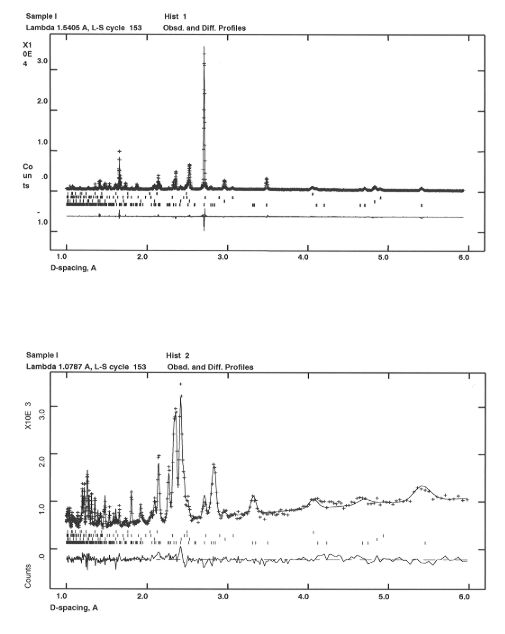

Braunite, Mn2+Mn63+O8SiO4, crystallizes in space group I 41/a c d and is stable over a wide range of temperatures, pressures and oxygen fugacity. It has a layered structure consisting of octahedral layers, containing Mn3+ (M2 and M3 sites), and layers containing eight-fold coordinated Mn2+ (M1 site), six-fold coordinated Mn3+ (M4 site) and tetrahedrally coordinated Si. Previous X-ray diffraction studies on Cu-substituted braunites showed that copper occupies predominantly the M1 site. Substitution of Cu2+ for Mn3+ on the M2, M3 and M4 sites was also considered but has not been confirmed beyond doubt.
In order to study further the mechanism of Cu substitution in braunite,
the cation distribution in two Cu-substituted braunite samples synthesized
by solid-state reaction has been determined by combined neutron and X-ray
Rietveld refinements. The samples with starting bulk composition CuMn6SiO12
(Sample I) and Cu0.5Mn6.5SiO12 (Sample
II) were annealed at 1050oC for about 12 days. The X-ray powder
diffraction patterns were measured on a Siemens D500 diffractometer. The
neutron powder diffraction pattern of Sample I was measured on the powder
diffractometer MAN1 at the research reactor FRM/Garching. The neutron powder
pattern of Sample II was measured on the time-of-flight diffractometer
ROTAX at the spallation source ISIS, UK. The samples contained minor quantities
of (Cu,Mn)3O4 spinel, Mn3O4,
Mn2O3,  -quartz and
-quartz and  -cristobalite. The Rietveld refinements were carried out with the GSAS
package.
-cristobalite. The Rietveld refinements were carried out with the GSAS
package.
Figure 3.3-5 shows the observed and calculated powder diffraction patterns
for Sample I. The multiphase refinements gave reliability factors Rp
= 6.2% for Sample I (a = 9.4200(2) Å, c = 18.6181(4) Å) and
Rp = 12.4% for Sample II (a = 9.4247(2)Å, c = 18.6688(4)
Å). The change of both the c parameter and the c/a ratio are in agreement
with previous studies according to which c and c/a decrease with increasing
copper content. The combined refinements show that in addition to the eight-fold
coordinated M1 site, a significant fraction of Cu enters the M3 site. The
selective substitution of copper onto the M3 site can be easily understood
as the result of the Mn3+ in the M3 site having the strongest
Jahn-Teller octahedral distortion.
 |
|
|

Tel: +49-(0) 921 55 3700 / 3766, Fax: +49-(0) 921 55 3769, E-mail: bayerisches.geoinstitut(at)uni-bayreuth.de
 Previous page
Previous page